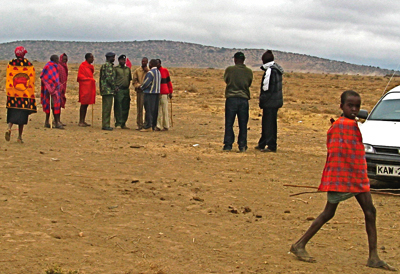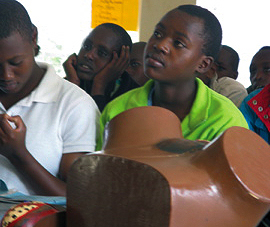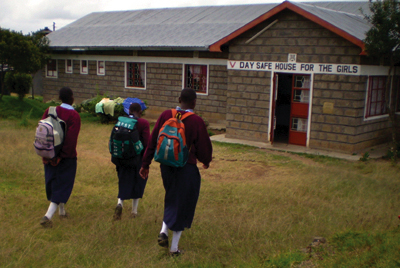10 Year Old Girl Dies from FGM--Circumciser Arrested
by Kim Rosen

On August 18, in the village of Narosura in the Rift Valley, a 10 year-old girl died from Female Genital Mutilation (FGM). At 5 that morning she was cut. By 10, she had bled to death.
Her family wrapped the body in a sheet and secretly buried it a few yards from their huts. By that afternoon, there was no evidence of the crime.
If it were not for the network of conscience that Agnes Pareyio has woven into the Maasai community, this child's death would have gone unnoticed. But an anonymous "informer" called her on the morning of the ceremony, in time for her to send one of her collaborators and an officer of the law to the hasty funeral.
As a result, for the first time in Maasai history, a circumciser has been arrested.
I have known of Agnes' work since the late nineties when Eve Ensler, founder of V-Day (www.vday.org), the worldwide movement to stop violence against women and girls, began collaborating with her. I remember hearing Ensler describe how she met Agnes in the Rift Valley, where the Maasai woman was traveling on foot from village to village, speaking out against her people's practices of FGM and ECM (Early Childhood Marriage) and educating the community about alternatives. At that time, she walked the miles of treacherous roads and donkey paths alone, carrying the "model" which has now become well known among those who work to stop FGM. The "model" is a plastic sculpture of a woman's pelvis with removable parts that fit into the pubic area. Each of seven or so exchangeable parts graphically represents a different form of FGM, as well as the medical complications that can ensue with time. The model, and the education Agnes brought with it, has had a huge impact in helping to eradicate this practice among the Maasai.

When Eve asked Agnes how V-Day could help her, she replied, "A Jeep would make it possible for me to get around more easily and save more girls." So V-Day bought Agnes a Jeep, not only enabling her to reach farther than she could on foot, but attracting trust and respect as people came to know her and her mission. Soon there was more interest in her work than she could address alone, and now she has trained several others to travel to the villages to teach girls, boys, parents, elders and leaders.
As Agnes reached more and more girls, some gained the courage to take control of their own lives and run away when they were in danger of being cut or forced into marriage. It soon became clear that a Safe House was needed for those girls who remained in danger living with their parents. The V-Day Safe House for the Girls (also called the Tasaru Rescue Center) was the next collaboration between V-Day and Agnes.
What began as Agnes' personal commitment to stopping FGM through education and sensitization has now become a multi-layered approach to community transformation. Through educational outreach into the villages, an invisible network of caring individuals has been put in place—women and men who are parents, teachers, church officials, and community leaders committed to informing the law of clandestine cutting ceremonies and aiding girls who need to seek refuge from them. The anonymous "informer" who called Agnes on August 18 was one of these.
I was visiting the Safe House when the call came in. I had come to work with the 40 or so girls who were living there during their vacation from boarding school. Girls at the Safe House are not only given refuge from FGM and ECM, each is placed in a primary or secondary school, and her school expenses are paid through graduation. This is revolutionary among the Maasai, where women and girls have been seen more as commodities than as contributing members of the community. In many villages, young girls are not permitted to go to school or are forced to drop out in order to be circumcised and sold into marriage. For a "bride price" of several cattle or sheep, a girl as young as 10 years old will become one of several wives belonging to a man many times her age.
August is a very busy month for the Tasaru Ntomonok Initiative. The Safe House is alive with girls home from school—studying, cooking, cleaning, playing soccer, or washing their clothes and laying them out to dry in colorful swatches strewn over the bushes and lawns. Between periods of study, the dining hall overflows with groups practicing line dances to "Bongo Flava" music (a kind of Kenyan hip hop), and singing in chorus in Swahili or Maa, the language of the Maasai. In the dorm, the girls engage in activities akin to teenagers all over the world—trying a new hat on one another, sharing jewelry, or watching the Olympics on a grainy-screened TV as they braid each other's hair.
August is also the time of the "Alternative Rite of Passage," a groundbreaking event that Agnes and her organization offer bi-annually. The ARP was created with the recognition that an alternative coming-of-age ritual was needed for girls to take the place of FGM. During the event, 60 – 80 girls from throughout the district gather for five days to learn about such things as sexuality, the dangers of FGM, and how to protect themselves from HIV/AIDS, rape, and early pregnancy. Tasaru provides them with lodging and food in a local boarding school free of charge.
The girls attend lectures in the mornings and afternoons, and everyday they meet in small groups with "Godmothers," older women from the Maasai community who are available to talk with them and answer their questions. The participants write songs and poems, take copious notes, and play games all focused on stopping FGM and empowering girls. At the end of the five days, they perform their creations at a joyful ceremony which many parents, district officials, religious leaders and activists attend.
August also has a darker side in Maasailand. Because schools in Kenya are on vacation, this is when many FGM and forced marriage ceremonies take place. It is a time when girls arrive at the Safe House, having fled a cutting ceremony or a wedding. Sometimes Agnes will be alerted by an informant before such an event, and will go with the police to rescue the girl.
The call on August 18 came too late to save the child in Narosura. However it was not too late to arrest those who circumcised her and make sure that justice prevailed. As soon as Agnes heard the news, she took action. Sending witnesses to the funeral and having the circumciser arrested was only the beginning. Even though FGM and ECM have been illegal in Kenya since 2001, many officers, as well as public officials and prosecutors, grew up in villages where these traditions are still practiced. It is not difficult to convince them to compromise. Agnes knew that the girl's family and others, including the local elected Counselor, would probably attempt to buy off the police to keep the story hidden. She knew that if she did not personally mobilize the police, the local Medical Officer and the Children's Officer to exhume the body and gain official proof of the cause of death, this girl would have died in vain.
It was only after hours of waiting at the police station, dozens of phone calls, and personally paying not only for the fuel for two vehicles to travel the treacherous road to Narosura, but also a stipend for the accompanying officers that the police agreed to the expedition.
When Agnes suggested that I accompany the men on the mission, I had no idea of the danger involved. I was unaware that the villagers, intent on keeping the exhumation from happening, had already planned to track our vehicle and set up an ambush.
So I was surprised when, arriving at the gas station in the center of town where we were to begin the journey, Agnes told me to leave the blue V-Day Jeep and get into one of the many battered, unmarked taxis that fill the streets of Narok. "We had to change the vehicle and travel undercover," she explained to me later. "The day before, three different people had casually asked me whether we were planning to take the Jeep to the exhumation—the man at the petrol station, one of the policemen, and the elected counselor from Narosura. It was then that I realized they must have already paid off the police and were planning an ambush. This is why you had to travel in a car they could not recognize."
I joined the Children's Officer, the doctor and Chris, who is the treasurer of Agnes' organization and her most active collaborator, in the taxi. After waiting for the police for half an hour at the agreed upon meeting point, we decided to go to look for them at the police station. There they were, unprepared, with no intention of making the journey. After another half hour of negotiations, three officers finally boarded the truck and were joined by were joined by the videographer that Agnes had hired to document the event.
Though this was usually the time of a short rainy season in Narok District, not a drop had been seen in months. As the taxi bounded and crashed over the rough terrain, the swirling clouds of dust were so thick that at times we were literally blinded and had to stop until visibility returned. Everything looked thirsty, the stunted brown bushes, the herds of wandering cows with their protruding ribs casting shadows on their skin, and even the herders, each wrapped in his bright red shuka (a Maasai blanket), the sudden stroke of color like an outcry against the relentless beige of the drought.
Suddenly the taxi stopped. All of us except the driver got out and began to walk across the barren savannah towards two huts about 10 minutes away. The taxi came too, leaving the road and bumping along behind us. "Stay close to the car," Chris warned me. "In case we have to run."
As we approached the huts, two Maasai men in western clothing and a woman in traditional Maasai dress of brightly colored material and many layers of beaded jewelry strode towards us. One of the men said he was the uncle of the girl. The other was the local elected Counselor.
An animated conversation ensued in whispered Maa between the uncle, the counselor and the doctor. Apparently the villagers were trying to "buy off" the officials. But in spite of the repeated offers, the doctor explained that there was no way to avoid the exhumation. Because of the presence of the witnesses from Tasaru, his reputation was at stake. He had to ascertain with his own eyes the cause of death.
After quite a while an agreement was reached. The doctor could exhume the body, but only the police could bear witness. One of the officers took my camera to document the exhumation. The police truck was maneuvered into a position that hid the proceedings.
I could certainly understand that the girl's community did not want the grave to be disturbed. I imagined this was because of religious beliefs and fears of black magic or other superstitions. Even while we were there several groups of women carrying 20 liter plastic water kegs on their backs, started to run as they approached, as if to pass through this blighted zone as quickly as possible. Chris had told me the death and the exhumation would cause many of the villagers to believe the area to be cursed now. They would take their livestock and move away. The girl's family, too, would probably burn their dung huts and evacuate, leaving the unmarked grave to disappear, anonymous in the dusty landscape.
It was not until I saw the photographs of the body of the 10 year old lying naked in the dirt that I realized what Agnes must have intuited all along. This was more complex than a simple case of FGM. The child's body, wrapped only in a blanket, was obviously about seven months pregnant. Maasai people who practice FGM believe the blood of an uncircumcised woman is unclean and will curse whoever comes in contact with it. So unless the girl was hurriedly cut, no one could help with such a birth and the child will be marked for life.

I learned later that the girl had already been promised to a very old man in marriage. The "bride price" had been paid. Apparently the wedding was planned as soon as the girl was cut and the baby was born and out of the way. Another reason for rushed FGM ceremony.
As the taxi driver negotiated the potholes and dust of the long road back to Narok, there was silence in the car. Seeing the photographs of the girl's body had thrown everyone into the heartbreak of the situation, not only putting a face on the child who had been victimized, but bringing home the reality that these violent practices are still being perpetrated upon Maasai girls in spite of years of activism against them.
"The fate of our girls is no longer a family issue," Agnes Pareyio said to 63 girls, their parents and local political and religious leaders at the closing ceremony of Tasaru Ntomonok's Alternative Rite of Passage the following Friday. "It is no longer even a tribal or national issue. It is an international necessity that these outdated practices be stopped. Though she may not die physically like the unfortunate young girl whose life was taken this week, each girl who is cut and forced into marriage undergoes a kind of death. Her future is changed forever. She cannot fulfill her potential and go on to give back to the community. And the world is denied a valuable participant in the evolution of Maasai life and culture."
Were it not for Agnes' work in the community, her insistence on justice, and the funds paid for the exhumation, this child's death would have gone unnoticed. "My work is to raise consciousness, to let everybody know," she said. "There is no way that I could ignore the cry of a girl who was killed by FGM then brutally buried. I must raise the alarm so she doesn't disappear into the ground without bringing awareness."

When I left the Safe House, Agnes' work had only just begun. The legal system that will try the case is easily compromised. It is not only possible to buy off the authorities at myriad junctures in the process, it is expected. At the time of this writing, the Tasaru Ntonomok Initiative hopes to raise the money to hire a lawyer to insure the prosecution proceeds truthfully, otherwise the case will surely go underground and never be recognized as the historic event that it truly is.
At the closing ceremony of the Alternative Rite of Passage, the girls who live at the Safe House performed several poems and songs about the importance of stopping FGM and educating girls. While most poems were spoken in chorus, Reginah Renu Masiaine, a petite girl of 15, spoke hers alone. Her voice rang out over the crowd, surprisingly clear and strong. The last stanza has stayed with me, sounding a summons for change:
Without a cut I can build a nation.
I can bring unity, love and hope where there is despair.
Father and mother, I am a child like a boy child.
Love, care and protection I needed from you.
Father, let me be me.
Though the work of Agnes and many others has greatly decreased the incidence of FGM in the Rift Valley, the child's death in Narosura is reminder that the work is not done. Please join V-Day and other anti-FGM initiatives to help put an end to these practices forever.






